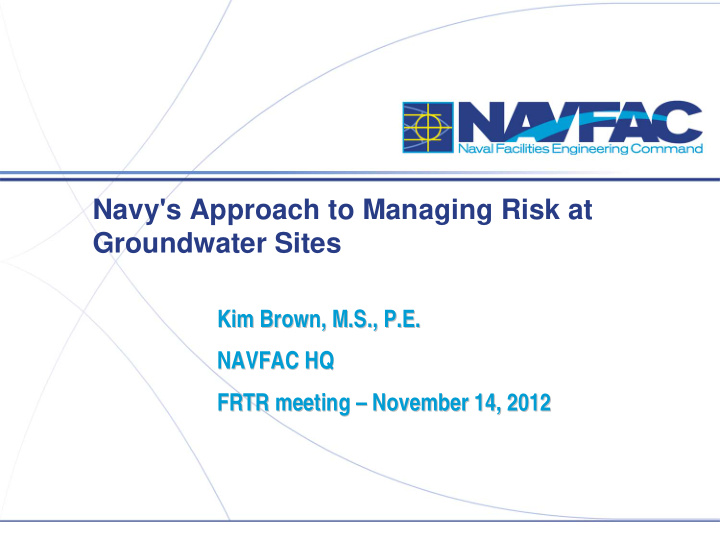



Navy's Approach to Managing Risk at Groundwater Sites Kim Brown, M.S., P.E. Kim Brown, M.S., P.E. NAVFAC HQ NAVFAC HQ FRTR meeting – – November 14, 2012 November 14, 2012 FRTR meeting
Risk Management • Many sites are relatively easy • Some sites have challenges – Large, low concentration plumes – Deep alluvial aquifers with fractured bedrock, or – Low permeability formations; Matrix Diffusion – DNAPL • Risk management can be used to determine if a site: – Requires remedial action – If it is technically feasible to achieve cleanup goals at a site • Manage risk, not the chemical! 2
Navy’s Toolbox Approach – Site Evaluation / CSM • Focus on GW useability and complete exposure pathways – Risk Management • Plume Management Zones, Point of Compliance – Remediation Strategies • Treatment Trains, Active vs. Passive, Containment , MNA as polishing technology – Optimization / Sustainability – New Tools • Mass flux • Plume stability/MNA software 3
Performance Objectives and Exit Strategies • Performance Objectives – Need to be developed and clearly defined – ITRC Integrated DNAPL Site Strategy- functional objectives should be specific, measurable, attainable, relevant, and time-bound (SMART) • Exit Strategies – When time to stop, modify, or change technology Conc. Conc. – “Asymptote” and “$/kg removed” important $/KG $/KG – Identify appropriate times to transition to other components of the treatment train Goals: Select remediation approach to achieve objectives. Goals: Select remediation approach to achieve objectives. Define clear end- -point point Define clear end 4
Typical Alternative Approaches to Groundwater Remediation • Groundwater plume management – Some states allow for plume management zones, alternate groundwater classification, alternate concentration limits (risk- based) – Containment systems (focus on plume migration control through pumping or permeable barriers) • Treatment + MNA over long time frames – Treat source/hot spots to extent practicable followed by MNA (often with extend timeframes) and/or other passive remediation technologies – Land-use controls to manage potential exposure during remediation 5
Alternative Approaches (Cont.) • Technical impracticability (TI) waiver • Adaptive site management (ASM) (from NRC 2000 Report and ESTCP ER-200832) – Iterative approach to site management similar to Terzaghi’s Observational Approach – Follows closely with the Navy’s Optimization Policy which requires optimization of every site at every phase of the CERCLA/RCRA/UST process – Manage remediation decision uncertainty through iterative refinement of CSM 6
Key References • Groundwater Risk Management Handbook, NAVFAC 2008 • Guidance for Optimizing Remedy Evaluation, Selection, and Design, NAVFAC, 2010 • Navy Optimization Policy, NAVFAC 2012 Use internet search or: https://portal.navfac.navy.mil/go/erb 7
Recommend
More recommend